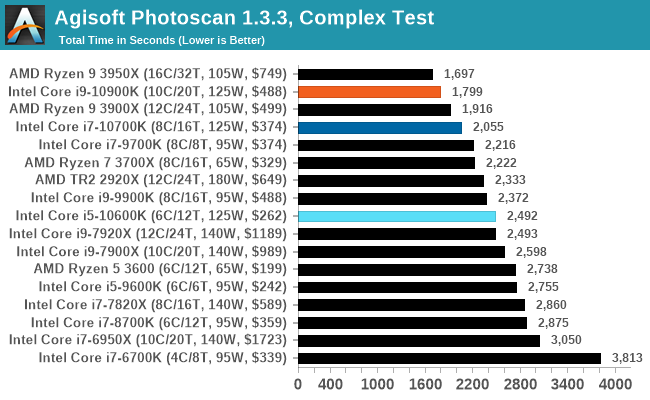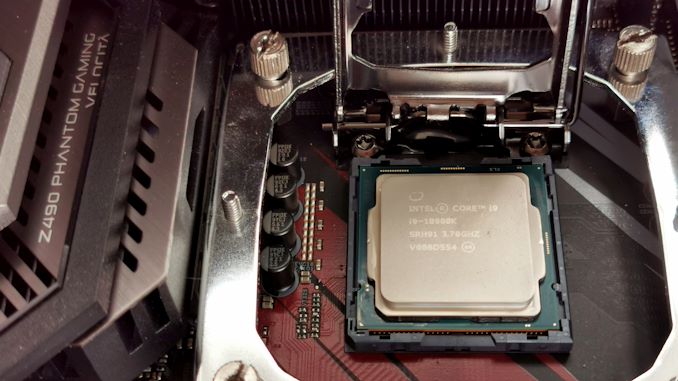The Intel Comet Lake Core i9-10900K, i7-10700K, i5-10600K CPU Review: Skylake We Go Again
by Dr. Ian Cutress on May 20, 2020 9:00 AM EST- Posted in
- CPUs
- Intel
- Skylake
- 14nm
- Z490
- 10th Gen Core
- Comet Lake
Conclusion: Less Lakes, More Coves Please
One thing that Intel has learned through the successive years of the reiterating the Skylake microarchitecture on the same process but with more cores has been optimization – the ability to squeeze as many drops out of a given manufacturing node and architecture as is physically possible, and still come out with a high-performing product when the main competitor is offering similar performance at a much lower power.
Intel has pushed Comet Lake and its 14nm process to new heights, and in many cases, achieving top results in a lot of our benchmarks, at the expense of power. There’s something to be said for having the best gaming CPU on the market, something which Intel seems to have readily achieved here when considering gaming in isolation, though now Intel has to deal with the messaging around the power consumption, similar how AMD had to do in the Vishera days.
One of the common phrases that companies in this position like to use is that ‘when people use a system, they don’t care about how much power it’s using at any specific given time’. It’s the same argument borne out of ‘some people will pay for the best, regardless of price or power consumption’. Both of these arguments are ones that we’ve taken onboard over the years, and sometimes we agree with them – if all you want is the best, then yes these other metrics do not matter.
In this review we tested the Core i9-10900K with ten cores, the Core i7-10700K with eight cores, and the Core i5-10600K with six cores. On the face of it, the Core i9-10900K with its ability to boost all ten cores to 4.9 GHz sustained (in the right motherboard) as well as offering 5.3 GHz turbo will be a welcome recommendation to some users. It offers some of the best frame rates in our more CPU-limited gaming tests, and it competes at a similar price against an AMD processor that offers two more cores at a lower frequency. This is really going to be a case of ‘how many things do you do at once’ type of recommendation, with the caveat of power.
The ability of Intel to pull 254 W on a regular 10 core retail processor is impressive. After we take out the system agent and DRAM, this is around 20 W per core. With its core designs, Intel has often quoted its goal to scale these Core designs from fractions of a Watt to dozens of Watts. The only downside now of championing something in the 250 W range is going to be that there are competitive offerings that do 24, 32, and 64 cores in this power range. Sure, those processors are more expensive, but they do a lot more work, especially for large multi-core scenarios.
If we remember back to AMD’s Vishera days, the company launched a product with eight cores, 5.0 GHz, with a 220 W TDP. At peak power consumption, the AMD FX-9590 was nearer 270 W, and while AMD offered caveats listed above (‘people don’t’ really care about the power of the system while in use’) Intel chastised the processor for being super power hungry and not high performance enough to be competitive. Fast forward to 2020, we have the reverse situation, where Intel is pumping out the high power processor, but this time, there’s a lot of performance.
The one issue that Intel won’t escape from is that all this extra power requires extra money to be put into cooling the chip. While the Core i9 processor is around the same price as the Ryzen 9 3900X, the AMD processor comes with a 125 W cooler which will do the job – Intel customers will have to go forth and source expensive cooling in order to keep this cool. Speaking with a colleague, he had issues cooling his 10900K test chip with a Corsair H115i, indicating that users should look to spending $150+ on a cooling setup. That’s going to be a critical balancing element here when it comes to recommendations.
For recommendations, Intel’s Core i9 is currently performing the best in a lot of tests, and that’s hard to ignore. But will the end-user want that extra percent of performance, for the sake of spending more on cooling and more in power? Even in the $500 CPU market, that’s a hard one to ask. Then add in the fact that the Core i9 doesn’t have PCIe 4.0 support, we get to a situation that it’s the best offering if you want Intel, and you want the best processor, but AMD has almost the same ST performance, better MT performance in a lot of cases, and a much better power efficiency and future PCIe support – it comes across as the better package overall.

Throughout this piece I’ve mainly focused on the Core i9, with it being the flagship part. The Core i7 and the Core i5 are also in our benchmark results, and their results are a little mixed.
The Core i5 doesn’t actually draw too much power, but it doesn’t handle the high performance aspect in multi-threaded scenarios. At $262 it comes in at more expensive than the Ryzen 5 3600 which is $200, and the trade-off here is the Ryzen’s better IPC against the Core i5’s frequency. Most of the time the Core i5-10600K wins, as it should do given that it costs an extra $60, but again doesn’t have the PCIe 4.0 support that the AMD chip offers. When it comes to building that $1500 PC, this will be an interesting trade-off to consider.
For the Core i7-10700K, at 8C/16T, we really have a repeat of the Core i9-9900K from the previous generation. It offers a similar sort of performance and power, except with Turbo Boost Max 3.0 giving it a bit more frequency. There’s also the price – at $374 it is certainly a lot more attractive than it was at $488. Anand once said that there are no bad products, only bad prices, and a $114 price drop on the 8c overclocked part is highly welcome. At $374 it fits between the Ryzen 9 3900X ($432) and the Ryzen 7 3800X ($340), so we’re still going to see some tradeoffs against the Ryzen 7 in performance vs power vs cost.
Final Thoughts
Overall, I think the market is getting a little bit of fatigue from continuous recycling of the Skylake microarchitecture on the desktop. The upside is that a lot of programs are optimized for it, and Intel has optimized the process and the platform so much that we’re getting a lot higher frequencies out of it, at the expense of power. Intel is still missing key elements in its desktop portfolio, such as PCIe 4.0 and DDR4-3200, as well as anything resembling a decent integrated graphics processor, but ultimately one could argue that the product team are at the whims of the manufacturing arm, and 10nm isn’t ready yet for the desktop prime time.
When 10nm will be ready for the desktop we don’t know - Intel is set to showcase 10nm Ice Lake for servers at Hot Chips in August, as well as 10nm Tiger Lake for notebooks. If we’re stuck on 14nm on the desktop for another generation, then we really need a new microarchitecture that scales as well. Intel might be digging itself a hole, optimizing Skylake so much, especially if it can’t at least match what might be coming next – assuming it even has enough space on the manufacturing line to build it. Please Intel, bring a Cove our way soon.
For the meantime, we get a power hungry Comet Lake, but at least the best chip in the stack performs well enough to top a lot of our charts for the price point.
These processors should be available from today. As far as we understand, the overclockable parts will be coming to market first, with the rest coming to shelves depending on region and Intel's manufacturing plans.












220 Comments
View All Comments
Gastec - Friday, May 22, 2020 - link
"pairing a high-end GPU with a mid-range CPU" should already be a meme, so many times I've seen it copy-pasted.dotjaz - Thursday, May 21, 2020 - link
What funny stuff are you smoking? In all actual configurations, AMD doesn't lose by any meaningful margin at a much better value.Anandtech is running CPU test where you set the quality low and get 150+fps or even 400+fps, nobody actually does that.
deepblue08 - Thursday, May 21, 2020 - link
Intel may not be a great value chip all around. But a 10 FPS lead in 1440p is a lead nevertheless: https://hexus.net/tech/reviews/cpu/141577-intel-co...DrKlahn - Thursday, May 21, 2020 - link
If that's worth the more expensive motherboard, beefier (and more costly) cooling, and increased heat then go for it. If you put 120fps next to 130fps without a counter up how many people could tell?Personally I don't see it as worth it at all. Nor do I consider it a dominating lead. But I'm sure there are people out there that will buy Intel for a negligible lead.Spunjji - Friday, May 22, 2020 - link
An entirely unnoticeable lead that you get by sacrificing any sort of power consumption / cooling sanity and spending measurably larger amounts of cash on the hardware to achieve the boost clocks required to get that lead.The difference was meaningful back when AMD had lower minimum framerates, less consistency and -30fps or so off the average. Now it's just silly.
babadivad - Thursday, May 21, 2020 - link
Do you need a new mother board with these? If so they make even less sense than they already did.MDD1963 - Friday, May 22, 2020 - link
As for Intel owners, I don't think too many 8700K, 9600K or above owners would seriously feel they are CPU limited and in a dire/ imminent need of a CPU upgrade as they sit now, anyway. Users of prior generations (I'm still on 7700K) will make their choices at a time of their own choosing, of course, and not simply because 'a new generation is out'. (I mean, look at 8700K vs. 10600K results.....; looks almost like a rebadging operation)khanikun - Wednesday, May 27, 2020 - link
I was on a 7700k and didn't feel CPU limited at all, but decided to get an 8086k for the 2 more cores and just cause it was an 8086. For my normal workloads or gaming, I don't notice a difference. I do reencode videos maybe a couple times a year. The only times I'll see the difference.I'll probably just be sitting on this 8086k for the next few years, unless something on my machine breaks or Intel does something crazy ridiculous, like making some 8 core i7 on 10nm at 5 ghz all core, in a new socket, then making dual socket consumer boards for it for relatively decent price. I'd upgrade for that, just cause I'd like to try making a dual processor system that isn't some expensive workstation/server system.
Spunjji - Friday, May 22, 2020 - link
Yes, you do. So no, they don't make sense xDGastec - Friday, May 22, 2020 - link
Games...framerate is pointless in video games, all that matters now are the "surprise mechanics".